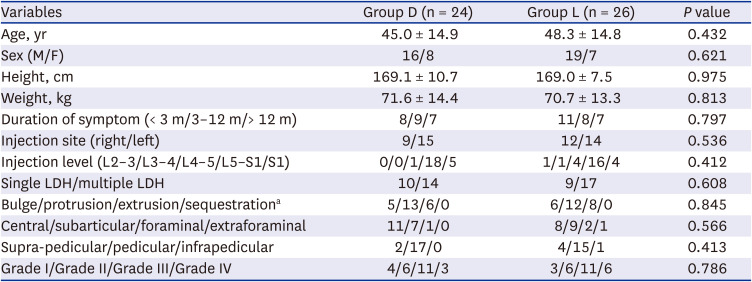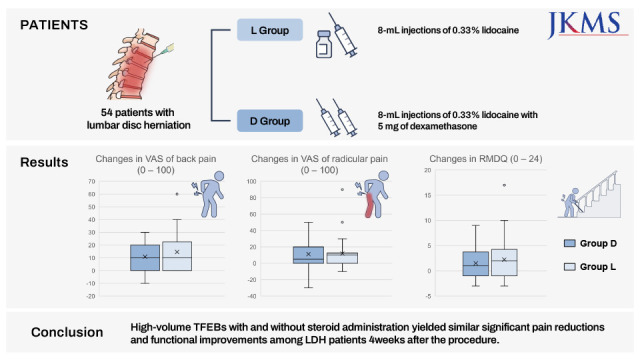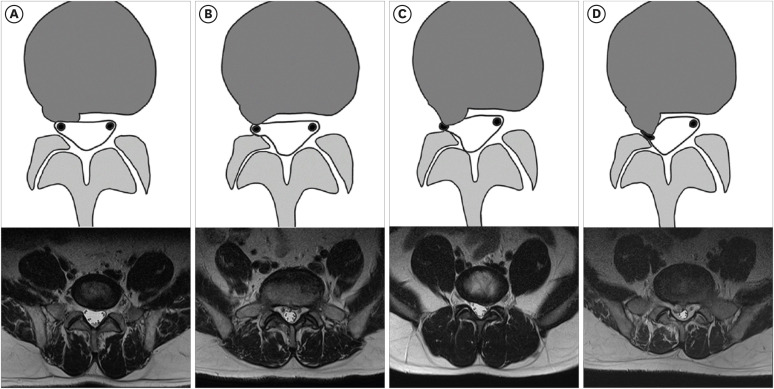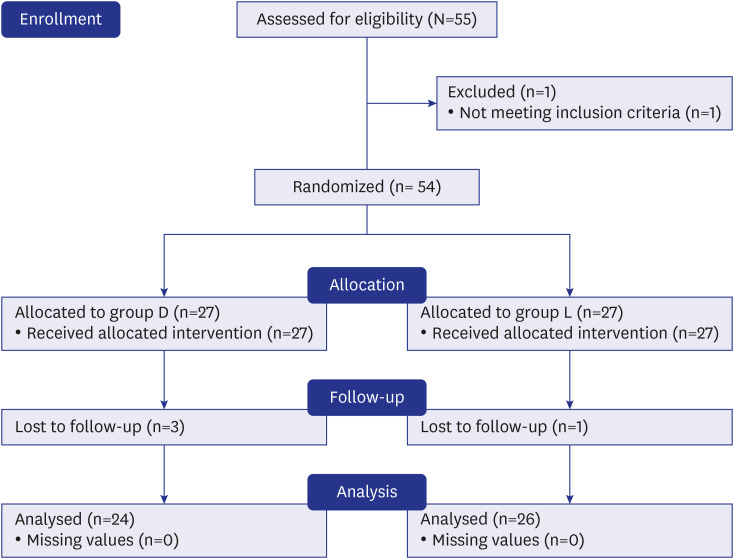1. Bogduk N. Epidural steroids. Spine (Phila Pa 1976). 1995; 20(7):845–848. PMID:
7701401.
2. Cuckler JM, Bernini PA, Wiesel SW, Booth RE Jr, Rothman RH, Pickens GT. The use of epidural steroids in the treatment of lumbar radicular pain. A prospective, randomized, double-blind study. J Bone Joint Surg Am. 1985; 67(1):63–66. PMID:
3155742.
3. Derby R, Kine G, Saal JA, Reynolds J, Goldthwaite N, White AH, et al. Response to steroid and duration of radicular pain as predictors of surgical outcome. Spine (Phila Pa 1976). 1992; 17(6):Suppl. S176–S183. PMID:
1631715.
4. van Tulder MW, Koes BW, Bouter LM. Conservative treatment of acute and chronic nonspecific low back pain. A systematic review of randomized controlled trials of the most common interventions. Spine (Phila Pa 1976). 1997; 22(18):2128–2156. PMID:
9322325.
5. Manchikanti L, Singh V, Pampati V, Falco FJ, Hirsch JA. Comparison of the efficacy of caudal, interlaminar, and transforaminal epidural injections in managing lumbar disc herniation: is one method superior to the other? Korean J Pain. 2015; 28(1):11–21. PMID:
25589942.
6. Manchikanti L, Buenaventura RM, Manchikanti KN, Ruan X, Gupta S, Smith HS, et al. Effectiveness of therapeutic lumbar transforaminal epidural steroid injections in managing lumbar spinal pain. Pain Physician. 2012; 15(3):E199–E245. PMID:
22622912.
7. Smith CC, McCormick ZL, Mattie R, MacVicar J, Duszynski B, Stojanovic MP. The effectiveness of lumbar transforaminal injection of steroid for the treatment of radicular pain: a comprehensive review of the published data. Pain Med. 2020; 21(3):472–487. PMID:
31343693.
8. Manchikanti L, Knezevic E, Knezevic NN, Vangala BP, Sanapati MR, Thota S, et al. A comparative systematic review and meta-analysis of 3 routes of administration of epidural injections in lumbar disc herniation. Pain Physician. 2021; 24(6):425–440. PMID:
34554683.
9. Stout A, Friedly J, Standaert CJ. Systemic absorption and side effects of locally injected glucocorticoids. PM R. 2019; 11(4):409–419. PMID:
30925034.
10. Chow RM, Rajput K, Howie BA, Varhabhatla N. The COVID-19 vaccine and interventional procedures: exploring the relationship between steroid administration and subsequent vaccine efficacy. Pain Pract. 2021; 21(8):966–973. PMID:
34314563.
11. Rabinovitch DL, Peliowski A, Furlan AD. Influence of lumbar epidural injection volume on pain relief for radicular leg pain and/or low back pain. Spine J. 2009; 9(6):509–517. PMID:
19398387.
12. Chun EH, Park HS. Effect of high-volume injectate in lumbar transforaminal epidural steroid injections: a randomized, active control trial. Pain Physician. 2015; 18(6):519–525. PMID:
26606003.
13. Fardon DF, Milette PC. Combined Task Forces of the North American Spine Society, American Society of Spine Radiology, and American Society of Neuroradiology. Nomenclature and classification of lumbar disc pathology. Recommendations of the Combined task Forces of the North American Spine Society, American Society of Spine Radiology, and American Society of Neuroradiology. Spine (Phila Pa 1976). 2001; 26(5):E93–113. PMID:
11242399.
14. Ghahreman A, Bogduk N. Predictors of a favorable response to transforaminal injection of steroids in patients with lumbar radicular pain due to disc herniation. Pain Med. 2011; 12(6):871–879. PMID:
21539702.
15. Karcioglu O, Topacoglu H, Dikme O, Dikme O. A systematic review of the pain scales in adults: which to use? Am J Emerg Med. 2018; 36(4):707–714. PMID:
29321111.
16. Jensen MP, Karoly P, Braver S. The measurement of clinical pain intensity: a comparison of six methods. Pain. 1986; 27(1):117–126. PMID:
3785962.
17. Lee JS, Lee DH, Suh KT, Kim JI, Lim JM, Goh TS. Validation of the Korean version of the Roland-Morris Disability Questionnaire. Eur Spine J. 2011; 20(12):2115–2119. PMID:
21479853.
18. Roland M, Fairbank J. The Roland-Morris Disability Questionnaire and the Oswestry Disability Questionnaire. Spine (Phila Pa 1976). 2000; 25(24):3115–3124. PMID:
11124727.
19. Kim WJ, Shin HY, Yoo SH, Park HS. Comparison of epidural spreading patterns and clinical outcomes of transforaminal epidural steroid injection with high-volume injectate via the subpedicular versus the retrodiscal approach. Pain Physician. 2018; 21(3):269–278. PMID:
29871371.
20. Bhatia A, Flamer D, Shah PS, Cohen SP. Transforaminal epidural steroid injections for treating lumbosacral radicular pain from herniated intervertebral discs: a systematic review and meta-analysis. Anesth Analg. 2016; 122(3):857–870. PMID:
26891397.
21. Manchikanti L, Knezevic E, Knezevic NN, Sanapati MR, Thota S, Abd-Elsayed A, et al. Epidural injections for lumbar radiculopathy or sciatica: a comparative systematic review and meta-analysis of cochrane review. Pain Physician. 2021; 24(5):E539–E554. PMID:
34323441.
22. Ghahreman A, Ferch R, Bogduk N. The efficacy of transforaminal injection of steroids for the treatment of lumbar radicular pain. Pain Med. 2010; 11(8):1149–1168. PMID:
20704666.
23. Coutinho AE, Chapman KE. The anti-inflammatory and immunosuppressive effects of glucocorticoids, recent developments and mechanistic insights. Mol Cell Endocrinol. 2011; 335(1):2–13. PMID:
20398732.
24. Franchimont D. Overview of the actions of glucocorticoids on the immune response: a good model to characterize new pathways of immunosuppression for new treatment strategies. Ann N Y Acad Sci. 2004; 1024(1):124–137. PMID:
15265777.
25. Nygaard OP, Mellgren SI, Osterud B. The inflammatory properties of contained and noncontained lumbar disc herniation. Spine (Phila Pa 1976). 1997; 22(21):2484–2488. PMID:
9383853.
26. Torebjörk HE, Ochoa JL, McCann FV. Paresthesiae: abnormal impulse generation in sensory nerve fibres in man. Acta Physiol Scand. 1979; 105(4):518–520. PMID:
452925.
27. Sugawara O, Atsuta Y, Iwahara T, Muramoto T, Watakabe M, Takemitsu Y. The effects of mechanical compression and hypoxia on nerve root and dorsal root ganglia. An analysis of ectopic firing using an in vitro model. Spine (Phila Pa 1976). 1996; 21(18):2089–2094. PMID:
8893432.
28. Takahashi H, Suguro T, Okazima Y, Motegi M, Okada Y, Kakiuchi T. Inflammatory cytokines in the herniated disc of the lumbar spine. Spine (Phila Pa 1976). 1996; 21(2):218–224. PMID:
8720407.
29. Manchikanti L, Boswell MV, Singh V, Benyamin RM, Fellows B, Abdi S, et al. Comprehensive evidence-based guidelines for interventional techniques in the management of chronic spinal pain. Pain Physician. 2009; 12(4):699–802. PMID:
19644537.
30. Mao J, Chen LL. Systemic lidocaine for neuropathic pain relief. Pain. 2000; 87(1):7–17. PMID:
10863041.
31. Sato C, Sakai A, Ikeda Y, Suzuki H, Sakamoto A. The prolonged analgesic effect of epidural ropivacaine in a rat model of neuropathic pain. Anesth Analg. 2008; 106(1):313–320. PMID:
18165597.
32. Tachihara H, Sekiguchi M, Kikuchi S, Konno S. Do corticosteroids produce additional benefit in nerve root infiltration for lumbar disc herniation? Spine (Phila Pa 1976). 2008; 33(7):743–747. PMID:
18379400.
33. Manchikanti L, Knezevic NN, Navani A, Christo PJ, Limerick G, Calodney AK, et al. Epidural interventions in the management of chronic spinal pain: American Society of Interventional Pain Physicians (ASIPP) comprehensive evidence-based guidelines. Pain Physician. 2021; 24(Suppl 1):S27–208. PMID:
33492918.
34. Shanthanna H, Busse J, Wang L, Kaushal A, Harsha P, Suzumura EA, et al. Addition of corticosteroids to local anaesthetics for chronic non-cancer pain injections: a systematic review and meta-analysis of randomised controlled trials. Br J Anaesth. 2020; 125(5):779–801. PMID:
32798067.
35. Manchikanti L, Cash KA, Pampati V, Falco FJ. Transforaminal epidural injections in chronic lumbar disc herniation: a randomized, double-blind, active-control trial. Pain Physician. 2014; 17(4):E489–E501. PMID:
25054399.
36. Tafazal S, Ng L, Chaudhary N, Sell P. Corticosteroids in peri-radicular infiltration for radicular pain: a randomised double blind controlled trial. One year results and subgroup analysis. Eur Spine J. 2009; 18(8):1220–1225. PMID:
19387704.
37. Riew KD, Yin Y, Gilula L, Bridwell KH, Lenke LG, Lauryssen C, et al. The effect of nerve-root injections on the need for operative treatment of lumbar radicular pain. A prospective, randomized, controlled, double-blind study. J Bone Joint Surg Am. 2000; 82(11):1589–1593. PMID:
11097449.
38. Cardoso MM, Carvalho JC. Epidural pressures and spread of 2% lidocaine in the epidural space: influence of volume and speed of injection of the local anesthetic solution. Reg Anesth Pain Med. 1998; 23(1):14–19. PMID:
9552773.
39. Thomas PS, Gerson JI, Strong G. Analysis of human epidural pressures. Reg Anesth. 1992; 17(4):212–215. PMID:
1515387.
40. Paul DL, Wildsmith JA. Extradural pressure following the injection of two volumes of bupivacaine. Br J Anaesth. 1989; 62(4):368–372. PMID:
2650729.
41. Maus TP, El-Yahchouchi CA, Geske JR, Carter RE, Kaufmann TJ, Wald JT, et al. Imaging determinants of clinical effectiveness of lumbar transforaminal epidural steroid injections. Pain Med. 2016; 17(12):2176–2184. PMID:
28025353.
42. Benzon HT, Rathmell JP, Wu CL, Turk DC, Argoff CE, Hurley RW. Practical Management of Pain. 15th ed. Philadelphia, PA, USA: Elsevier/Saunders;2014. p. 1115.
43. Joswig H, Neff A, Ruppert C, Hildebrandt G, Stienen MN. The value of short-term pain relief in predicting the long-term outcome of lumbar transforaminal epidural steroid injections. World Neurosurg. 2017; 107:764–771. PMID:
28838872.
44. Fairbank JC, Pynsent PB. The Oswestry Disability Index. Spine (Phila Pa 1976). 2000; 25(22):2940–2952. PMID:
11074683.







 PDF
PDF Citation
Citation Print
Print






 XML Download
XML Download